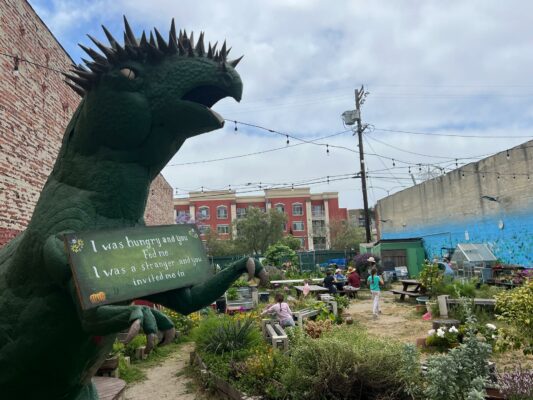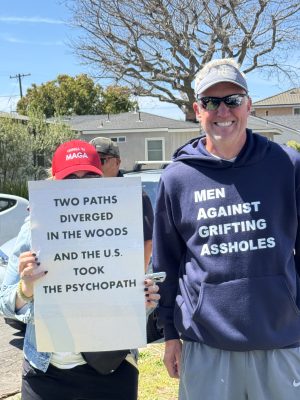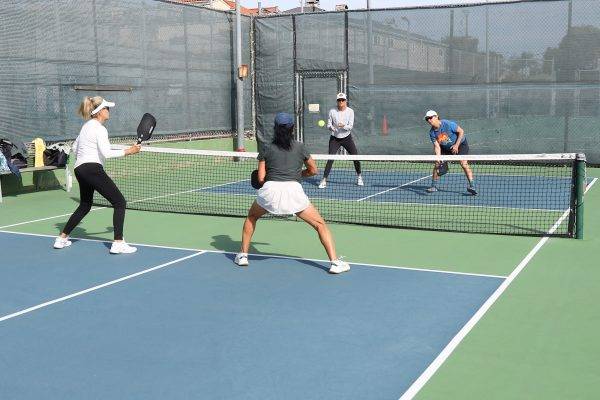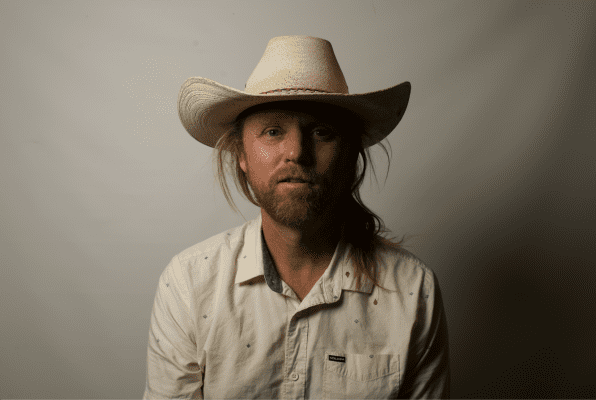
In April 2014, builder Chuck Lande invited golf course designer David McClay Kidd to walk the Rolling Hills Country Club golf course. That year, Kidd’s Gamble Sands in Brewster, Washington, had been named the best new golf course in the United States by Golf Digest. Kidd had already achieved golfing immortality with the opening of Bandon Dunes in Oregon in 1999. Bandon Dunes was modeled after St. Andrews, golfing’s Scottish birthplace, and the equally historic Scottish course Gleneagles, where Kidd grew up as the son of the golf course’s superintendent.
Lande grew up in Rancho Palos Verdes in a home his mother still lives in. He attended Chadwick School and USC and is the founder of The Chadmar Group, named after his son Chad and daughter Marisa. Chadmar built the Grand Del Mar Golf Club, its 134 fairway homes and the neighboring, five-star Grand Del Mar Hotel.
Lande planned to build 114 fairway homes at Rolling Hills and wanted Kidd to design the club’s new golf course.
“I looked at the practice range and thought, Oh, this may not be all I had hoped for. It was, not the worst I’d seen, but close,” Kidd would recall. “It was obvious the course had been cobbled together over generations and not a lot of thought had been given to the overall composition.”
“I was on the point of thanking Chuck for the opportunity and leaving when we reached the highest point of the course and I was able to look down into the quarry. It wasn’t a rock quarry. It was a sand quarry.”
“Sand is the elixir of life to a golf course designer. Knowing we had hundreds of acres of sand next to the course meant we had the sacred ingredient needed to make a great course, ” Kidd said.
Kidd was also attracted by the opportunity to build a course overlooking Los Angeles, adding views of a third global city to TPC Stonebrae, overlooking San Francisco and Beaverbrook, overlooking London.
A third appeal, which Kidd alluded to during a recent visit to Rolling Hills, was the opportunity to quiet his critics.
‘I’ve heard a few green-eyed monsters say my courses are successful because I get great sites,” he said. That criticism wouldn’t apply to the Rolling Hills site because Kidd planned to level the site, literally.

Into the rough
Kidd was correct in his assessment that the course had been cobbled together. Rolling Hills Country Club opened in 1963 as a par-3, nine-hole course squeezed onto 14 acres along Palos Verdes Drive East. A round cost $1.25. In 1972, the members, whose aspirations were apparent in the club’s name, signed a lease with the neighboring Chandler Sand and Gravel company for another 66 acres, enabling the course to expand to 18 holes across 99 acres. The new, 6,112 yard course was designed by Ted Robinson, from the Arnold Palmer Design Company. It was a traditional parkland course, with tree-lined fairways, neatly groomed bunkers, rose gardens and ponds with Palos Verdes flagstone waterfalls dotting the namesake rolling hills.
In 2000, the Chandler family (no relation to the Los Angeles Times’s Chandlers) told the club they wanted to sell the 66 acres they had leased to the club. They also planned to sell the adjacent, 61-acre sand and
quarry, which the family founded in the 1930s. Sand and gravel from the quarry had been used to build Marineland of the Pacific in 1954. In a precursor to repurposing, when the park was torn down in 1987, the aquarium’s concrete was trucked back to the quarry and resold as land fill.
The 66-acre lease ran through 2022. The club had until then to acquire the property or close.
The purchase promised to be both costly and complicated. Approvals would need to be obtained not only from the city of Rolling Hills Estates, but also Torrance (the quarry straddled the Torrance border), three school districts, six property owners associations, utility companies, environmentalists, Native Americans and over 20 governmental regulatory agencies, including the FAA.
In addition, the club’s board needed to convince its 465 equity members to pay a $40,000 assessment, each, and to continue paying dues during the two years the club would be closed while a new course and clubhouse were built.
Over 100 members left. Most resigned rather than attempting to sell their memberships and pay the $25,000 transfer fee.
Finally, in 2008, at a party at the clubhouse, with the 80-year-old Arnold Palmer as guest of honor, a jubilant club club board announced that a deal had been reached.

Developer John Laing Homes would acquire the Chandler property. The city would rezone part of the property for residential development, in exchange for which Laing would fill in the noxious quarry, eliminating pollution and traffic from the quarry’s 200 daily truck trips. Torrance would receive $10 million for allowing its portion of the quarry to be annexed by Rolling Hills Estates. The country club would receive title to 131 acres, including the quarry, in exchange for helping the home builder obtain the necessary entitlements and for building a first class golf course that would enhance the value of the fairway homes.
Rather than being forced to close in 2022, the club was to emerge from the negotiations with a new, $62 million, 160-acre, Arnold Palmer-designed golf course and a new 60,000 square foot clubhouse overlooking the course and the Los Angeles Basin.
The $400 million project was arguably to be the largest residential and recreational community development in the history of the South Bay and almost certainly larger than any that will be approved in the future.
“All we were waiting for was for the developer to transfer money to the escrow account. And then the Great Recession of 2008 hit,” current club president Aubie Goldenberg said during a recent interview.
“Venerable Irvine developer John Laing Homes, one of the nation’s largest, filed for bankruptcy protection Thursday, joining the growing ranks of residential builders laid low by the collapse of the housing market,” the Los Angeles Times reported shortly after the agreement was reached.

Lucky lie
Lande lives in Santa Barbara. But his sister still lives in Palos Verdes. During the summer of 2013, her son Jake was working in the club’s pro shop. Jake’s grandmother, on his father’s side, is a founding member of the club.
One day that summer, Jake invited his first cousin Chad, Lande’s son, to play golf. Between holes, Jake asked Chad why he and his dad didn’t step in to save the club. Chad, a former financial analyst, was working with his dad. He had been unaware of the club’s problem.
“That evening, Chad called me and asked if I knew John Robertson,” Lande recalled. “I said, ‘Sure. In high school, I worked with John’s sister at Pat’s Ski and Sport in Riviera Village.’”
Robertson was a third generation Chandler and president of the sand and gravel company. He was heading up the family’s effort to sell the property. He had been interviewing half a dozen other home builders when Lande called him.
“I think he picked us because we had experience with similar developments,” Lande said.
Lande’s experience spanned the spectrum, from great success with the Del Mar course, to a course “put on hold” by the Great Recession in Snow Creek, Mammoth.
“We built 800 homes in Snow Creek. It had an existing nine hole golf course that we were going to replace with a new course, along with 600 new homes and a five-star hotel.”
The stalled Snow Creek course had one significant, residual benefit. Lande met Kidd.
“We worked with Tom Fazio on the Del Mar course. He’s a great golf course designer. But golf goes through phases. There was a period when Fazio, Nicklaus and Palmer were the kings. And I’m not saying they aren’t still. But as far as we’re concerned, David is the king today,” Lande said.
Lande met Kidd through longtime friend and landscape architect David Howerton, whose San Francisco firm Hart Howerton is doing the landscaping at Rolling Hills. Howerton had worked with Kidd at Bandon Dunes.

Onto the green
Last May, Rolling Hills Country Club held a party to announce that a new agreement had been reached to build a new golf course, a new clubhouse and 114 new homes. This time, Kidd was the guest of honor and Lande the home builder.
“When it’s finished, it will look like it’s been here 100 years,” Kidd told the members.
It was an audacious promise. Not a blade of grass, not one of the 980 jacaranda, pepper, pine or eucalyptus trees, nor the 100-foot high namesake rolling hills were to remain of the old course.
Kidd is known for designing “links” courses. Links is a Scottish term that refers to coastal areas, where the early Scottish golf courses were built on land unsuitable for any other purpose.
Any doubt about the club’s commitment to the new plan, was erased by a YouTube video posted a few days later. The video showed club general manager Greg Sullivan in his black Dodge Charger, and board member Kerry Welsh in his midnight blue Tesla Model S, drag racing down the old number 5 fairway and doing donuts on the green.
“Greg always hated the number 5 hole,” construction superintendent Bob Vaughey, who was riding in Welsh’s car, says on the video.
Last August, trucks began dumping sand from the quarry at staging areas around the course while Caterpillar scrapers, commonly used to scrape coal bowls, began leveling the hills and emptying their 80-ton loads into the cavernous quarry. Six million cubic yards of dirt would be scooped up and emptied into the quarry.
Hillside neighbors, behind the white picket fences that border the course, now wake up to a view of the sun rising over the San Gabriel mountains, east of the LA Basin. In winter, the view will include snow covered Mount Baldy.
Vaughey describes the new course as “one big tea saucer, or drainage project.”
“Essentially, that’s what golf courses are. They’re almost always built in a flood zone.”
To channel the water that flows onto the course from two large canyons on the western edge, Vaughey’s crews carved barrancas, modeled after the natural barranca that makes the first hole at the Riviera Country Club, home of the LA Open, so intimidating.
The barrancas, or arroyos, flow into an irrigation lake, which replenishes the aquifer, 182 feet beneath the former quarry.
Water rights secured during the negotiations guarantee the club healthy fairways and greens, regardless of drought conditions. Computerized sprinkler heads reduce the one million gallons typically required to water an 18 hole course by 60 percent, Lande said.
While the hills were being leveled and the 150-foot deep, 1,000-foot wide quarry filled, fairway grass was being grown by West Coast Turf, in Thermal City, near Palm Springs. The company supplies grass for most of the sports facilities in the west, including the Rose Bowl and Dodger Stadium. Last month, six to eight West Coast Turf trucks, each carrying 8,000-square-foot rolls of turf, began daily deliveries. Groundskeepers unrolled the turf like carpet, at the rate of a fairway a week.
“Life is short. It would have taken a year to grow the fairways from seed,” Vaughey said.
He plans to have the course ready for play next June, less than two years after he did donuts on the number 5 green in Welsh’s Tesla.
The 60,000-square-foot, $35 million clubhouse, clad in Palos Verdes flagstone and bordered by trimmed, green hedges, is scheduled to open next August. It is being built by Suffolk Construction and was designed by architect Bob Altevers, whose other golf course clients have included PGA West in La Quinta, Pelican Hill in Newport and Lande’s Del Mar Club in Del Mar.
The clubhouse will overlook seven holes where there was once a sand and gravel quarry and the LA basin, beyond. It will offer fine and casual dining rooms and a banquet room, a ballroom, wine cellar, gym and a spa. Adjoining the clubhouse will be tennis, bocce ball, pickleball and basketball courts, a Junior Olympic-sized pool and a zero-entry pool surrounded by cabanas.
A 10-acre golf facility will include a 350-yard driving range that converts to a 9-hole, par-3 course whose greens, approaches and bunkers mimic the 18-hole course.
The clubhouse complex is as important to the club’s future as the golf course, general manager Sullivan said. Successful new golf clubs are increasingly designed to appeal to families.
Rolling Hills offers non-golfing, social memberships, which are crucial to a golf club’s home sales, Lande said.
“Typically, only 25 percent of home buyers at a golf club are golfers, but almost everyone enjoys swimming, tennis and dining,” he said.
The new, ranch style homes will be 3,200 to 5,800 square feet on 12,000 square foot lots. Lande said he expects buyers will be older Peninsula couples who want more amenities and less home maintenance and young Beach Cities families who want yards.
Model homes will be completed in December 2017, Lande said. He declined to disclose the home prices, except to say they will be priced at market value.

Golf according to Kidd
One afternoon last month, after walking the course with construction supervisor Vaughey, general manager Sullivan, board member Welsh and this reporter, the group seated itself around a low table in the old clubhouse and listened to Kidd’s thoughts on golf course design.
Kidd asked Sullivan his handicap. Sullivan answered 13.
“Imagine if I designed a 400-yard hole, with a 100-yard wide fairway, no bunkers and the cup in the middle of the green. What do you think your chances would be of parring the hole?
After hesitating a moment, Sullivan ventured, “50-50.”
“What if I shaped the fairway like a taco and upped your chances of par to 60 percent. Wouldn’t that be more fun to play?” Kidd asked.
“My detractors say I make courses too easy. But no golf is easy. Not if 50 percent of the time a good golfer can’t par an easy hole,” Kidd said.
Following his success at Bandon Dunes, Kidd said, he succumbed to the prevailing wisdom that a golf designer’s job was to “defend par.”
“The locals call Tetherow in Bend ‘Deatherow.’ And that’s my home course,” he said. Kidd moved to Bend, Oregon, shortly after Tetherow opened in 2008, just ahead of the Great Recession.
“Ego reigned. Harder was better. Every golf designer wanted to brag about how hard their courses were, making them 8,000 yards long with 24-yard wide fairways and a slope ratings of 148. (Slope rating is a measure of a course’s difficulty, with 155 being the maximum difficulty.)
“We were doing what clients wanted and that was generate a maximum amount of media attention because most were selling houses.”
“Designers talked about ‘Tiger proofing’ courses because Tiger made the game look too easy.”
Golf course designer Pete Dye expressed the then prevailing philosophy in 2002, when he was commissioned to design the Trump National Golf Course, overlooking the ocean, on the opposite side of the Peninsula from Rolling Hills.
“The pros are the only people who like an easy course. And they’re a bunch of crybabies. And you can quote me,” Dye said.
Told that his courses are described as “Dyeabolical,” he shot back, “Have you ever heard of a great, easy course? This course will be tough on players who come out only once or twice a year. But the ardent golfer who shoots 95 will love it. He may curse it, but he’ll go home to Omaha and tell all his buddies they’ve got to play it.”
Last year, Trump National was scheduled to host the PGA Grand Slam of Golf. The tournament was canceled following protests over Trump’s comments about illegal immigrants.
“In 2008,” Kidd said, “I had an epiphany. Harder is not better. Fun is better. Why did people love the early courses I designed, when I knew so little? And why weren’t they returning to play the courses I did 10 years later when I knew so much more?”
“Golf is already one of the hardest sports there is, and you want me to make it harder? Imagine if tennis had to be played with wooden rackets and skiers had to use straight skis.”
“There’s a saying that courses should be easy to bogey, but difficult to birdie, which sounds good, but is rarely achieved.”
Welsh mentioned the old adage that golf is 90 percent psychological and 10 percent mental.
Kidd, a 6 handicap, said he learned that early on as a golfer.
“But it took me a long time to understand what that meant for a golf course architect,” he said. “We’ve been taught that golf is all about intimidation and playing defense. I’m turning that on its head. I want my courses to breed confidence. Then golf becomes fun.”
“When you stand at the tee, do you feel confidence, or trepidation? Are you looking down at that $4 Titleist Pro, thinking ‘I’ll never see it again’?”
“If you hit a rank shot, out of bounds, I can’t help you. But keep it in bounds and I’ll do my best to keep you playing golf with one ball.”
“Confidence translates into a confident swing. If you played a great round at Bandon Dunes, it’s not because it’s an easy course. It’s because you played confidently.”
Kidd traced the divergence between the Scottish links courses he grew up with and America’s less forgiving parkland courses to the 1933 opening of Augusta National, the Churchill Downs of golf, with its colorful flower boxes, tree lined fairways and bright white, egg-shaped bunkers.
“Never was the iron gauntlet of challenge more skillfully concealed in velvet,” the legendary Bobby Jones said of the course he helped design. “The architect assumes the role of defender against the golfer attacking the course,” he wrote in “Golf by Design.”
“Every April, golfers watched the Augusta Masters on their color TVs and dusted off their clubs. Groundskeepers looked at Augusta and thought, ‘That’s my benchmark,’” Kidd said.
“Then Bandon Dunes opened and American golfers were able to experience the golf I grew up with — its wiry grasses, multiple colors, imperfect nature.”
“I spent my childhood at St. Andrews and Gleneagles. That’s the only golf I knew.”
“When I came to Bandon Dunes to meet with (owner) Mike Kaiser, I had never played a Pete Dye, an Arnold Palmer, a Jack Nicklaus or a Tom Fazio course.
“I knew Kaiser had already talked to Nicklaus and Fazio and didn’t think I had a chance. So I told him what I thought, that he should keep it simple because the land was already so good. A few weeks later, he called and asked, ‘Do you really believe what you said?’”
“He thought golf had gone down a course it wasn’t meant to go down and he wanted someone unencumbered by American golf’s overcontrolled and overspending look.”
“So, he hired someone who didn’t know enough to screw it up.”
Kidd was 27. As he had proposed, he left the relatively flat, nearly treeless site largely alone, wrapping the fairways around the brown sand bunkers that had always been there.
When Bandon Dunes opened in 1990 it triggered a revolution in golf course design in the U.S.
“Whatever else I achieve, I believe Bandon Dunes marked a turning point in my life and I believe it marked a turning point in golf in America. Sophisticated American golfers already understand that,” Kidd said.
Like Bandon Dunes, Rolling Hills’ fairways will be defined by strips of tall grass rather than trees. Its bunkers will be the brown sand that has always been there.
“The fairways are very sinuous,” he said. “I want you to be able to hit the ball high and wide and still be able to find it,” Kidd said.
When asked what quality makes a great golf designer, Kidd answered, “Visualization. You must be able to paint in your mind’s eye something that doesn’t exist.”
Lande’s contract called for grading the site to within 18 inches of Kidd’s specifications.
At that point, Kidd said, “Course design changes from an engineering exercise to a lot of hand waving, flag planting and foot dragging [to outline the bunkers and greens].”
“The trick is to make the course look as random as nature. It’s whimsy that excites golfers. If it looks engineered, it’s not cool.”
“I admire Tom Fazio. His courses are beautiful, but too perfect. Pete Dye is not so perfect, but he’s kind of evil. I’m aiming for something in between.”
Kidd said he played Trump National and walked off after the 12th Hole. “It was like going to the dentist,” he said.
“People look at the old Scottish courses and ask, why is there a hump in the fairway? It’s there because it was there. No one shaped it. My challenge here is to make features look like they were there when they weren’t. I’m having to engineer randomness.
“Luis, who’s designing the bunkers doesn’t play golf. He’s an artist. I let him do his thing. He built a bunker with a grass hump in the middle.
“I keep telling Greg to stop telling people we filled in the quarry and leveled the hills. I want them to look at the course and think it’s always been that way.”
The group asked Kidd how their course would measure up to other Los Angeles area courses.
He responded by speaking admiringly of Riviera, in Pacific Palisades, whose 1926 design is largely unchanged and possesses some of the characteristics of a links course.
He also spoke admiringly of Los Angeles Country Club’s newly redesigned North Course.
“I’d love it if comparisons were made between our course and LA North. To be spoken of in the same breath as Gil Hanse would be cool. Gil studied aerial photos from the ‘20s of George Thomas’s original design and paid homage to it. I hope 100 years from now, people will do that with this course.”
Then Kidd disclosed his aspirations for the new Rolling Hills course.
“It stands a chance to be one of the best courses not only in Los Angeles, but maybe in the world,” he said.
Presumably, he was including Bandon Dunes, with which it will share many characteristics and one notable exception.
Bandon Dunes is a privately, owned pay by the round course and hosts 150,000 rounds a year. The nearby airport is the busiest private airport in the Northwest. Rolling Hills’ 465 members will never have trouble getting a tee time on their David Kidd course. Nor is the nearby Torrance Airport, the reason the new course needed FAA approval, likely to be impacted.
As the conversation wound down, Kidd was asked how difficult he thought their course would be.
“I want the slope rating to be in the 115 to 120 range. More than 120 is too much,” he said. (113 is considered average difficulty).
“I want your pro to think he can shoot a 59. I don’t want him to actually shoot a 59. I just want him to think he can. And maybe he will, if he holes every put.” Pen











